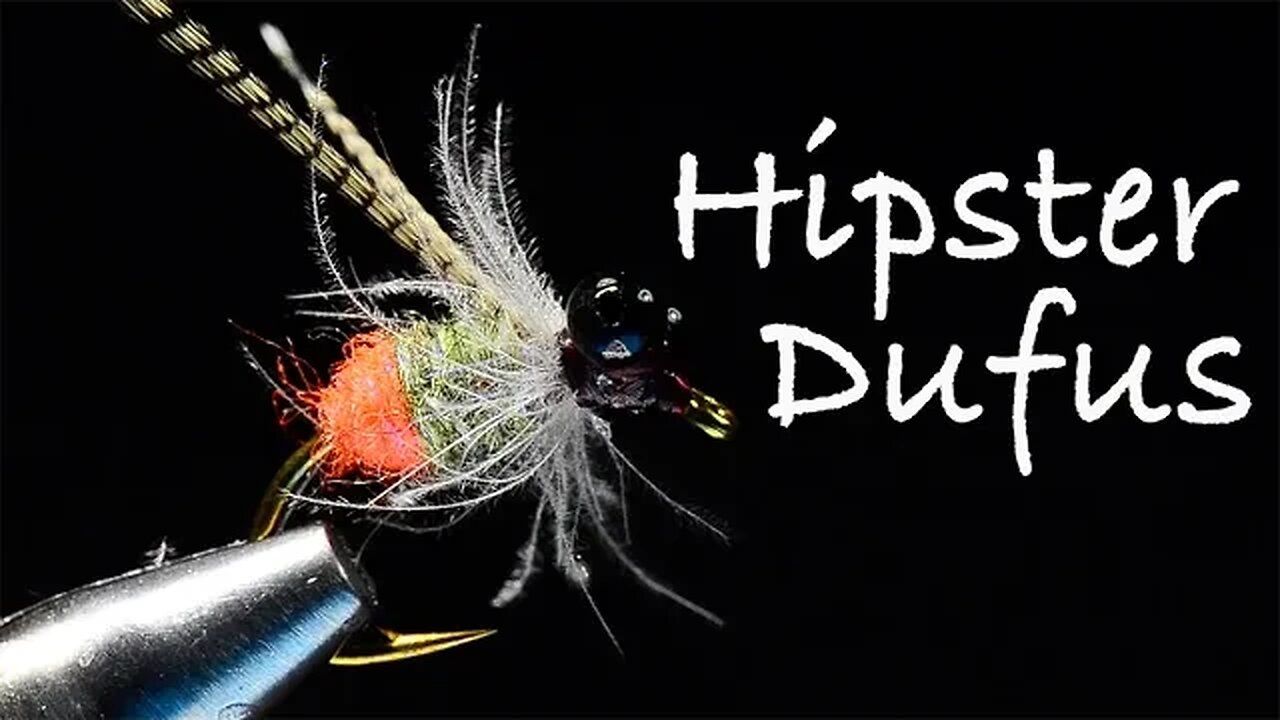Premium Only Content

Hipster Dufus - Carp Fly Tying - Tied By Charlie Craven
Hipster Dufus Fly Tying Recipe:
(Click the links below to purchase the materials from Charlie)
Hook: #8 Tiemco 2457
https://charliesflybox.com/products/tmc-2457-100pk
Thread: Wine 70-denier and 140-denier UTC Ultra Thread
https://charliesflybox.com/products/140-denier-utc-thread
Lift Kit: Two 4mm sections of .030" lead wire
https://charliesflybox.com/products/lead-wire
Eyes: Black medium bead chain
https://charliesflybox.com/products/bead-chain-eyes-2
Abdomen: Fluorescent orange Senyo’s Laser Dub
https://charliesflybox.com/products/senyo-s-laser-dub
Thorax: Olive Senyo’s Laser Dub
https://charliesflybox.com/products/senyo-s-laser-dub
Wings: Black and white barred wood duck flank feathers
Collar: White CDC
https://charliesflybox.com/products/premium-cdc-small-bag
Carp fishing used to be something that people laughed about. Carp were called trash fish and usually thrown up on the bank when they were accidentally caught by us elitist trout anglers. Then, in 1997 Brad Befus, Barry Reynolds, and John Berryman published the book Carp on the Fly. And in 1998, Dave Whitlock wrote “Stalking the Golden Ghost” in Fly Fisherman magazine and revealed that he’d been flats fishing for carp for more than a decade. Slowly but surely, fly fishing for carp began to get the attention it deserved.
It doesn’t take many dedicated fishing days to realize that carp are definitely not pushovers, and can be every bit as crafty and wily in shallow water as a brown trout or bonefish. They spook at the slightest flaw in your presentation and can be downright frustrating,
but when the magic finally happens, you quickly discover that they pull much harder than trout, grow to ridiculous sizes, and can run you into your backing in a flash. I have often said good sight fishing for carp is more like bonefishing than actual bonefishing.
The Denver metro area just happens to be home to a plethora of Front Range lakes that harbor good populations of sizable carp, as well as the lower reaches of the famous South Platte River as it runs through downtown. The availability of these fish creates easy before- and after-work forays, but because the fish themselves can be difficult, catching them consistently often ends up becoming a time-consuming quest. Many other states have good fishable carp populations where they inhabit shallow water and become available to fly fishers. Lake Michigan is home to some real brutes in clear water, and that sounds like a whole lot of fun.
In the 1990s, fly fishers used standard trout flies like Woolly Buggers and San Juan Worms, and those flies often still work today, but over the years guys like Daryl Eakins have created purpose-built carp patterns to tempt these tough fish. As a result, the carp game has changed immensely. Eakins hails from Detroit, Michigan, but now lives just outside Denver and took my beginning fly-tying class in 2017. He immediately stood out as a star pupil, and quickly grasped the idea of design and functionality in a fly, and started his own company, Nervous Water Flies, in 2019. As of this writing, Daryl has four of his patterns picked up for commercial distribution by Umpqua Feather Merchants as well. You could say things are going well for him!
Eakins credits Jay Zimmerman’s Banksia Bug as the inspiration behind his Hipster Dufus, and Zimmerman himself for the design of the intricate internal weighting system, which assures the fly always lands and rides hook point up.
This “lift kit” employs two very specifically measured and tested pieces of lead wire, not only to add weight and create a solid foundation for the beadchain eyes, but also to lift the eyes up and away from the shank, making the pattern top-heavy, and guaranteeing that it always flips over with the hook point up. It’s really an ingenious design, and I’m surprised it’s not used on more patterns.
Zimmerman’s pattern has a reverse-tapered body to imitate a free-living caddis larva, and Eakins used this feature, albeit in a much more robust form, in his Hipster Dufus. Eakins painstakingly builds a very prominent abdomen with a brighter-colored dubbing, usually orange or yellow, then covers the front two thirds with a more earthy shade like olive or brown. He allows a bit of the brighter dubbing to remain at the bend to create a hot spot and doesn’t sweat it if some of the brighter dubbing shows through the top layer, thinking of it as a “faux rib” throughout the body. Eakins then ties in a matched clump of black and white barred wood duck flank feathers widely spread out to the sides to stabilize the fly.
Eakins designed his fly as a multi-use pattern that he could flip, drop, drag, or bomb at his targets and still stand a good chance of hooking up. He credits the relationship between the abdomen and thorax for creating the perfect silhouette, and he likes the CDC collar for the bit of “panache” it adds to a lowly carp fly.
PLEASE SUBSCRIBE!! - http://bit.ly/2FhqqtL
-
 1:22:03
1:22:03
Graham Allen
3 hours agoGRAHAM MAKES YUGE ANNOUNCEMENT!! + LIBERAL REP ROOTING AGAINST AMERICA?!
50.5K50 -
 1:01:28
1:01:28
Randi Hipper
1 hour agoETHEREUM PRICE BOUNCES AFTER BILLION DOLLAR HACK!
8.7K1 -
![Massive Paradigm Shift: Bongino Hired At FBI; Joy Reid Fired At MSBNC [EP 4450-8AM]](https://1a-1791.com/video/fwe1/52/s8/1/u/2/_/e/u2_ey.0kob-small-Massive-Paradigm-Shift-Bong.jpg) DVR
DVR
The Pete Santilli Show
16 hours agoMassive Paradigm Shift: Bongino Hired At FBI; Joy Reid Fired At MSBNC [EP 4450-8AM]
58.4K18 -
 1:27:17
1:27:17
Game On!
15 hours ago $2.71 earnedAnother Monday without football...
36.8K8 -
 1:43:56
1:43:56
Jeff Ahern
3 hours ago $2.60 earnedMonday Madness with Jeff Ahern (Ding Dong the Witch is Gone!)
29.4K3 -
 34:56
34:56
Athlete & Artist Show
23 hours ago $1.78 earnedCANADA WINS GOLD AGAIN!!
25.8K2 -
 15:27
15:27
T-SPLY
1 day agoCNN Forgets President Trump Can Fire Anyone He Wants From The Pentagon
36.9K25 -
 15:13
15:13
Clownfish TV
22 hours agoBluesky Trusts the Science? Scientists FLEEING X for Bluesky!
46.8K10 -
 29:50
29:50
The Finance Hub
17 hours ago $8.95 earnedBREAKING: TULSI GABBARD JUST DROPPED A MAJOR BOMBSHELL!!!
41.9K39 -
 11:32
11:32
ariellescarcella
18 hours ago"Being A Lady Boy Is Exciting!" (This Dude Has A Kid)
28.9K8